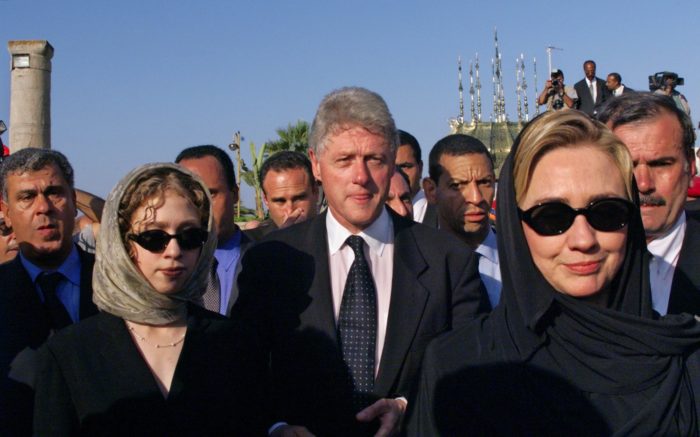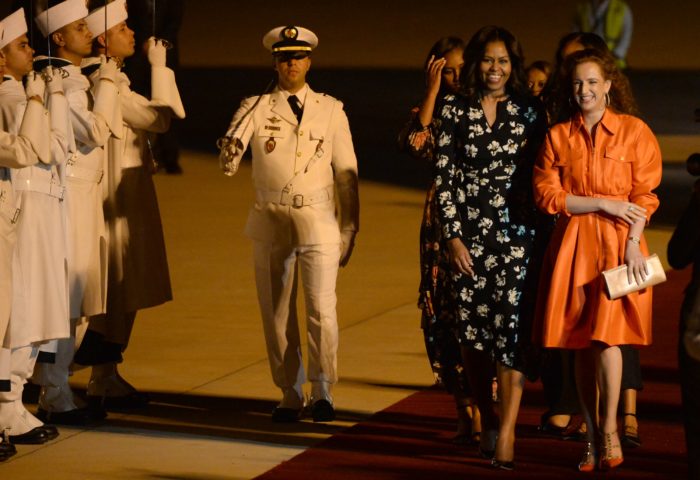Article originally published in TelQuel 879, November 8
In December 1959, US President Dwight Eisenhower landed Air Force One in Casablanca for the first and last time. At the invitation of King Mohammed V, the American head of state was concluding a tour of the Middle East with an express visit to Morocco. Mohammed V and Eisenhower signed an agreement authorizing the US military to use Moroccan airbases for missions in the Middle East and Africa.
Since then, no US President has made an official visit to the Kingdom. Yet, in the twilight of Hassan II’s reign, a new form of parallel diplomacy is emerging between Morocco and the United States. For the past 20 years, it has not been American presidents, but rather their First Ladies, who have taken it upon themselves to represent the White House in Morocco.
They all do so with a common objective: to improve the situation of Moroccan women. A parallel diplomacy that frees itself from the American bipartisanship, as always when it comes to foreign policy.
The origins
In 1995, Hassan II travelled to Washington to meet Bill Clinton, then occupying the Oval Office. As is traditional in Moroccan-American relations, the two heads of state discussed relations between their respective countries and the situation in the Middle East, at a time when the Oslo Accords were being negotiated in secrecy.
Of particular note was the couscous served at the dinner hosted by Bill Clinton for the King, who was accompanied by Prince Moulay Rachid and Princess Lalla Meryem. In the images filmed by American television, the Prince and Princess can be seen chatting with First Lady Hillary Clinton.
The romance between the American First Lady and Morocco began on that visit. A US diplomatic cable leaked by Wikileaks in October 2009 reports an exchange between an American diplomat and former Foreign Minister Taïeb Fassi Fihri. The document highlights a major turning point in relations between the Kingdom and the United States: the visit of Hillary Clinton, then First Lady, to Morocco in 1999.
« Our American Aunt »
In the spring of 1999, Hillary Clinton and her daughter Chelsea embarked on an eleven-day tour of the Middle East that took them to Egypt, Tunisia and Morocco. The two women spent more than half, six days, of their « spring break » in the kingdom. Their playground: the south of the country.
In Ouarzazate, Missour, Errachidia and Merzouga, mother and daughter received a welcome worthy of a head of state. The Clintons’ Moroccan sojourn came to a close in Marrakech, where one princely and royal reception followed another for a trip initially billed as a « private visit ».
Hillary and Chelsea were first received by Princess Lalla Meryem at the Palais Badii, before being offered dinner by Crown Prince Sidi Mohammed. The Moroccan visit concluded with a reception hosted by Hassan II. On this auspicious occasion, the First Lady Hillary Clinton appeared in a red caftan.
It didn’t take much for the Moroccan press to fall under her spell. In an article devoted to the Clintons’ trip, Maroc Hebdo referred to the First Lady as « Our American Aunt. » The weekly even went so far as to say that « Hillary Clinton has touched the Moroccan soul« .
This Moroccan trip had a completely different echo in the American press. As rumors of her future candidacy for the U.S. Senate gather momentum, the Washington Post sees in this trip to Morocco the birth of a « diplomatic Hillary Clinton« . In an article devoted to the First Lady’s trip, she is described, almost prophetically, as « a candidate for secretary of state. »
Indeed, during her visit to Marrakech, Hillary Clinton spoke at length on the most pertinent international issues of the moment, such as the NATO strikes in Yugoslavia and the Middle East peace process.

With the family
Clearly charmed by her trip to Morocco, Hillary Clinton returned two months later. At the beginning of June 1999, she went to Fez to inaugurate a maternity hospital funded by American aid. The following day, she headed for Ifrane to deliver a speech to the first graduating class of Al Akhawayn University, of which she is the official patron.
As the graduates looked on, the First Lady delivered a speech in which she emphasized, as did those who came after her, the need to include women and promote their rights. In Ifrane, she also inaugurated the Hillary Clinton Center, which aims to empower women in the region through the establishment of cooperatives.
« King Hassan II considered us members of his family »
Hillary Clinton returned to Morocco almost a month later, where she and the entire Clinton family attended the funeral of King Hassan II in July 1999. It was an opportunity for President Clinton to deliver a speech to American citizens gathered at the American Embassy in Rabat, in which he testified to Hillary Clinton’s attachment to Morocco: « Hillary has been to Morocco twice, if not more, and I think she’s considering moving to Morocco« . He also refers to the Clinton family’s closeness to the Palace: « King Hassan II, when our family came to Morocco, not only made us feel at home, but considered us members of his family. And I told King Mohammed VI that we would be honored if he felt like a member of our family. »
The fruits of a relationship
The Palace cultivated its ties with the Clinton family, and the family returned the favor. In her book The Final Days, dedicated to the end of Bill Clinton’s presidency, journalist Barbara Olson reveals that the sovereign gave five caftans to the American First Lady. Even when President Clinton left the White House, the ties were maintained.
Like the Chirac family, Bill and his daughter Chelsea were among the guests at Mohammed VI’s wedding to Lalla Salma. The Clintons presented the sovereign with a painting by Arab-American artist Helen Zughaib, and the bride with a pair of gold earrings, as revealed in a documentary devoted to Bill and Hillary’s life outside the White House.
After eight years in the U.S. Senate, between 2001 and 2009, Hillary Clinton ran for the highest office in the land. She was ultimately defeated by the sensational Barack Obama. But Morocco was still able to reap the rewards of its close relationship with Hillary, as she was chosen by the new president to head US diplomacy as Secretary of State.
During her four years at the helm of the State Department, Hillary Clinton continued to strengthen Morocco-US relations. She was one of the dignitaries attending the presentation of the Moroccan Solar Plan; a project quite dear to Mohammed VI. Snapshots taken during the event show the complicity between the King and the diplomat, who can be seen laughing heartily during the presentation.
The « friendship » between Mohammed VI and Hillary Clinton is also mentioned in certain unofficial diplomatic exchanges between Morocco and the United States. It is also under her aegis that the Morocco-US strategic dialogue will be set up, a platform for exchange between the two countries that the kingdom wanted to see.
Despite her presence at the head of the State Department, Hillary Clinton was not been able to influence the change of tone desired by the White House on the Sahara issue. Whereas under the Bush administration, the Moroccan autonomy plan had been welcomed, it was no longer mentioned in official American discourse. Hillary Clinton eventually resigned from the Secretary of State’s office in February 2013. A few months later, Mohammed VI travelled to New York to meet the former diplomat. The meeting between the Sovereign and the not-yet-candidate for the presidency of the United States was the subject of an official press release from the Royal Cabinet.

Michelle in default of Barack
When Hillary Clinton stepped down as head of US diplomacy, she was replaced by John Kerry. The United States adopted a tone that moved away from the Moroccan position. Washington even incurred the wrath of Rabat by suggesting the addition of a human rights monitoring mechanism to the mandate of the United Nations Mission for the Sahara (Minurso). Mohammed VI is received by Barack Obama, no doubt in a bid to reconcile views. And as his presidency draws to a close, his wife Michelle and their two daughters arrive in the kingdom as part of an international tour.
As First Lady, Michelle Obama was there to promote the status of women. Through her Let Girls Talk initiative, she funds programs alongside the Millennium Challenge Corporation to create extracurricular activities, provide internships and set up gender equality training for teachers, among others. The trip was be the subject of a documentary film, but did not contribute to a change in the relationship between the Obama administration and Morocco.

Trump, his daughter and son-in-law
In the spring of 2015, Hillary Clinton announced her entry into the race for a new bid for US Presidency. A few weeks later, Bill Clinton traveled to Marrakech with their daughter Chelsea to take part in the Clinton Global Initiative, an annual event organized by the Clinton Foundation.
His participation caused a stir in the American press when e-mails leaked that were attributed to Hillary Clinton’s team. At the heart of the controversy was a donation from OCP to the foundation run by the Clinton couple. The controversy was eventually exploited by Clinton’s rival, Donald Trump, the winner of the race for the White House.
The tradition of parallel diplomacy conducted by the families of American presidents continues after the election of Donald Trump. Witness the visits made by his advisor and son-in-law, Jared Kushner. Keen to promote his peace plan for the Middle East, Ivanka Trump’s husband travelled to Morocco to meet Mohammed VI, who chaired the Al Quds Committee. Although officially the subject had not been raised, the trip nevertheless had a sentimental connotation for Donald Trump’s son-in-law.
Accompanied by Minister Mohcine Jazouli, Kushner visited the grave of tzaddik (Jewish dignitary) and Kabbalist Haïm Pinto, a respected leader and revered rabbinical judge in the Jewish community of Essaouira, where a synagogue still bears his name.
The deceased was none other than the grandfather of Rabbi David Hanania Pinto, who advised the Trump campaign during his 2016 bid for the US Presidency. David Hanania Pinto also played a key role in the reconciliation between Jared Kushner and Ivanka Trump when the couple was going through a difficult phase, points out Aomar Boum, author and UCLA professor, in his essay A Kabbalist in the White House.
The American president’s daughter also visited Morocco to improve the status of women, like her predecessors Hillary Clinton and Michelle Obama. But that’s not all. Her involvement in the public policies of the Trump administration has given her the image of an unofficial First Lady. Ivanka Trump thus perpetuates the tradition of parallel, family diplomacy between American heads of state and Morocco.
Written in French by Yassine Majdi, edited in English by AngloMedia




